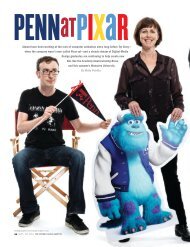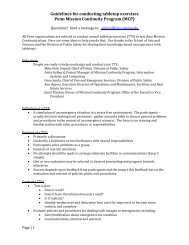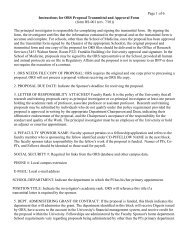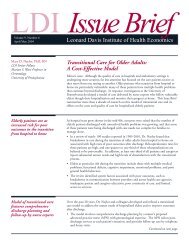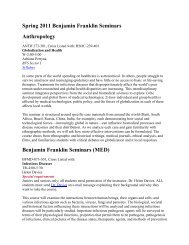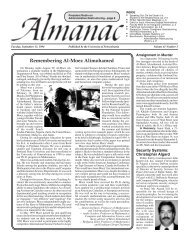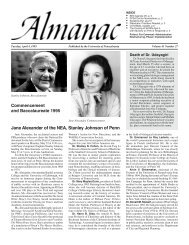Download this article (PDF) - University of Pennsylvania
Download this article (PDF) - University of Pennsylvania
Download this article (PDF) - University of Pennsylvania
You also want an ePaper? Increase the reach of your titles
YUMPU automatically turns print PDFs into web optimized ePapers that Google loves.
convinced Whitaker <strong>of</strong> her key role in the development <strong>of</strong> <strong>this</strong><br />
last plan. “I suddenly figured out these are Harriet’s drawings<br />
that show the shift in that November/December model,” says<br />
Whitaker. “Harriet’s the one who’s throwing down the first<br />
ideas and making the shift. So who does Lou turn to when he<br />
has to redesign the Garden? Harriet. Is it exactly what Kahn<br />
decided? No. Kahn made some differences. But the stairs—the<br />
kind <strong>of</strong> grand set <strong>of</strong> steps? That’s sketches Harriet made.”<br />
She had another idea that should not be forgotten: a canal,<br />
separating the park from the ruins just to the north.<br />
“I thought, ‘Hmm, why not bring in the water, and then have<br />
bridges which would control the entrance, and have a series<br />
<strong>of</strong> steps here so that you could go under the bridges?’” she<br />
recalls. “You could arrive by boat, which I think would be very<br />
exciting, and make these two bridges the entrance. Because<br />
we had not resolved the entrance at that point.”<br />
The Room was still evolving as well. Nathaniel Kahn has a<br />
vivid memory <strong>of</strong> being at his father’s <strong>of</strong>fice at 1501 Walnut<br />
Street one autumn night when both his parents were working<br />
intently on the project.<br />
“I remember Lou working on and thinking about the Room,” he<br />
says. “There was a [wooden] model, and the wall was divided into<br />
two, and it had a slit. At one point it was at an angle to let sun in<br />
at certain times <strong>of</strong> the year, and other times it was straight. And<br />
he was pulling the wall apart and putting it back together. And<br />
he asked me, ‘How far apart do you think it should be?’”<br />
Nathaniel, who only turned 11 that November, was thrilled to be<br />
asked. “But more than expecting the right answer from me, it’s sort<br />
<strong>of</strong> a window into the way that he thought about things and the way<br />
he worked,” he says. “He liked to talk as he worked. And it didn’t<br />
matter whether you were young or old or an architect or not. He<br />
wasn’t necessarily interested in your solution, but he was interested<br />
in what a conversation with you might bring out for him.”<br />
The memory has the quality <strong>of</strong> a fairy tale, he says: “The wise<br />
old philosopher king wants to know what the right move is, and<br />
who does he choose but a little boy to ask a question <strong>of</strong>. Somehow,<br />
in engaging the little boy, he comes up with some ideas. And by<br />
the time I have that specific memory from working on the Room,<br />
it had already become very close to what it is today.”<br />
Sunday, March 17, 1974. Kahn had just arrived back in New<br />
York from Ahmadabad, India, where the Indian Institute<br />
<strong>of</strong> Management he had designed was under construction.<br />
He was about to catch a train to Philadelphia in order to teach<br />
his Monday classes at Penn. Then, in a<br />
Penn Station men’s room, his entangled<br />
heart gave out. It took three days before<br />
his family and friends and colleagues<br />
found out what had happened to him.<br />
The story <strong>of</strong> his complicated personal life<br />
has been told many times, most movingly<br />
in My Architect. In addition to Sue Ann<br />
(his daughter by his wife, the late Esther<br />
Israeli Kahn Ed’27 G’33) and Nathaniel,<br />
he also had a daughter, Alexandra Tyng<br />
GEd’77, with the late architect Anne Tyng<br />
Gr’75 [“Journey to Estonia,” Jan|Feb 2007].<br />
His death was obviously very hard on all <strong>of</strong><br />
(Left) Harriet Pattison in the Room. (Below)<br />
One <strong>of</strong> her many sketches for the memorial.<br />
(Far left) “Consider the momentous event in<br />
architecture when the wall parted and the<br />
column became.”<br />
THE ARCHITECTURAL ARCHIVES, UNIVERSITY OF PENNSYLVANIA<br />
THE PENNSYLVANIA GAZETTE MARCH | APRIL 2013 45



